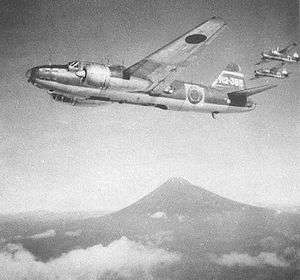701st Naval Air Group
| 701st Naval Air Group | |
|---|---|
|
Mitsubishi G4M1 R2-385 of 702nd Attack Squadron in September 1944. | |
| Active |
November 1, 1942 – March 15, 1943 February 20, 1944 – postwar. |
| Country |
|
| Allegiance | Empire of Japan |
| Branch |
|
| Type | Naval aviation unit |
| Role |
Until 15 March 1943 Bomber, torpedo bomber And after 20 February 1944 Fighter, bomber, torpedo bomber, reconnaissance |
| Size | 48 aircraft (initial) |
| Part of |
22nd Air Flotilla 51st Carrier Division 25th Air Flotilla 5th Air Fleet |
| Garrison/HQ |
Bihoro, Japan Tinian, Marianas Ruot, Kwajalein Atoll Vunakanau, New Britain Toyohashi, Japan Kanoya, Japan Kokubu, Japan |
| Aircraft flown |
G3M Type 96 "Nell" G4M Type 1 "Betty" P1Y Ginga "Frances" D3A Type 99 "Val" D4Y Suisei "Judy" B6N Tenzan "Jill" B5N Type 97 "Kate" A6M Type 0 "Zeke" C6N Saiun "Myrt" |
| Engagements | |
| Insignia | |
| Identification symbol |
M (1942) R2 (February 1944) 01 or 701 (November 1944) |
The 701st Naval Air Group (第七〇一海軍航空隊 Dai Nana-Maru-Hito Kaigun Kōkūtai) was an aircraft and airbase garrison unit of the Imperial Japanese Navy (IJN) during the Pacific campaign of World War II.
First generation (ex-Mihoro Naval Air Group)
Structure
- Higher unit
- 22nd Air Flotilla (1 November 1942–15 March 1943, dissolved.)
- Commanding officers
Second Generation (ex-Toyohashi Naval Air Group)
Structure
- Higher unit
- 51st Carrier Division (20 February 1944–14 November 1944)
- 25th Air Flotilla (15 November 1944–9 February 1945)
- 5th Air Fleet (10 February 1945–postwar)
- Lower unit
- 305th Fighter Squadron (20 March 1945–5 May 1945)
- 311th Fighter Squadron (5 March 1945–24 May 1945)
- 5th Attack Squadron (5 January 1945–9 February 1945)
- 102nd Attack Squadron (1 October 1944–9 December 1944)
- 103rd Attack Squadron (1 October 1944–postwar.)
- 105th Attack Squadron (10 February 1945–postwar.)
- 251st Attack Squadron (10 February 1945–19 April 1945)
- 252nd Attack Squadron (1 October 1944–14 December 1944)
- 256th Attack Squadron (1 January 1945–9 February 1945)
- 406th Attack Squadron (25 January 1945–9 February 1945)
- 702nd Attack Squadron (1 April 1944–9 October 1944)
- 3rd Reconnaissance Squadron (15 November 1944–9 February 1945)
- Commanding officers
- Captain Yutaka Yamada (20 February 1944–4 September 1944)
- Captain Tatsuhiko Kida (5 September 1944–28 May 1945)
- Captain Yoshio Enoo (29 May 1945–postwar)
Footnotes
Bibliography
- The Japanese Modern Historical Manuscripts Association, Organizations, structures and personnel affairs of the Imperial Japanese Army & Navy, University of Tokyo Press, Tōkyō, Japan, 1971, ISBN 978-4-13-036009-8.
- Bunrin-Dō Co., Ltd., Tōkyō, Japan.
- Famous airplanes of the world
- No. 59, Type 1 Attack Bomber, 1996, ISBN 4-89319-056-3.
- No. 91, Type 96 Attack Bomber, 2001, ISBN 4-893-19089X.
- Koku-Fan Illustrated No. 42, Japanese Imperial Army & Navy Aircraft Color, Markig, 1988.
- Famous airplanes of the world
- Model Art, Model Art Co. Ltd., Tōkyō, Japan.
- No. 406, Special issue Camouflage & Markings of Imperial Japanese Navy Bombers in W.W.II, 1993.
- No. 458, Special issue Imperial Japanese Navy Air Force Suicide Attack Unit "Kamikaze", 1995.
- No. 553, Special issue I.J.N. Carrier Attack Bomber, 2000.
- Heihachi Yoshitake (One of the members of the Mihoro Naval Air Group), Biography of the Mihoro Naval Air Group, K.K. Art Insatsu, Bihoro, Japan, 1982.
- Alumni Association of the 705th Naval Air group, History of the 705th Naval Air Group, Sougo Insatsu Kougei K.K., Tokyo, Japan, 1985.
- Japan Center for Asian Historical Records (http://www.jacar.go.jp/english/index.html), National Archives of Japan, Tōkyō, Japan.
- Reference Code: C08051771200, Transition table of formation of Imperial Japan Navy Air Units (special establishment) during Pacific War, Japan Demobilization Agency, 1949.
This article is issued from Wikipedia - version of the 5/16/2016. The text is available under the Creative Commons Attribution/Share Alike but additional terms may apply for the media files.
